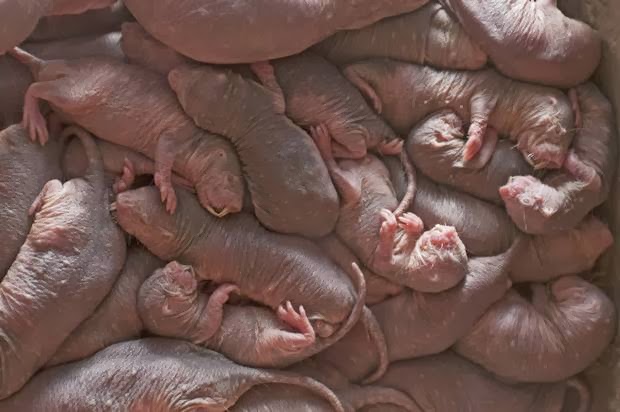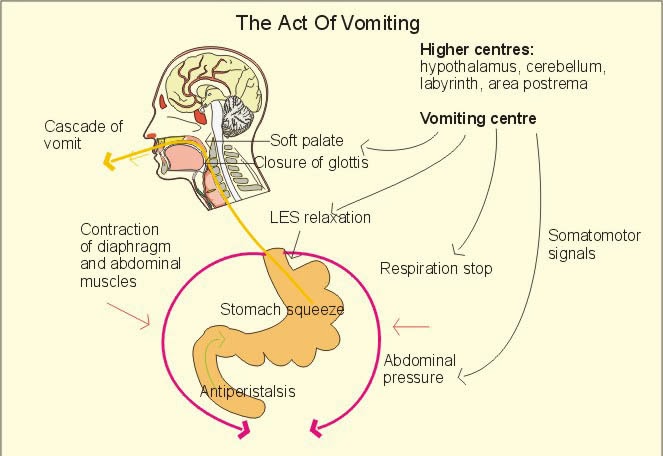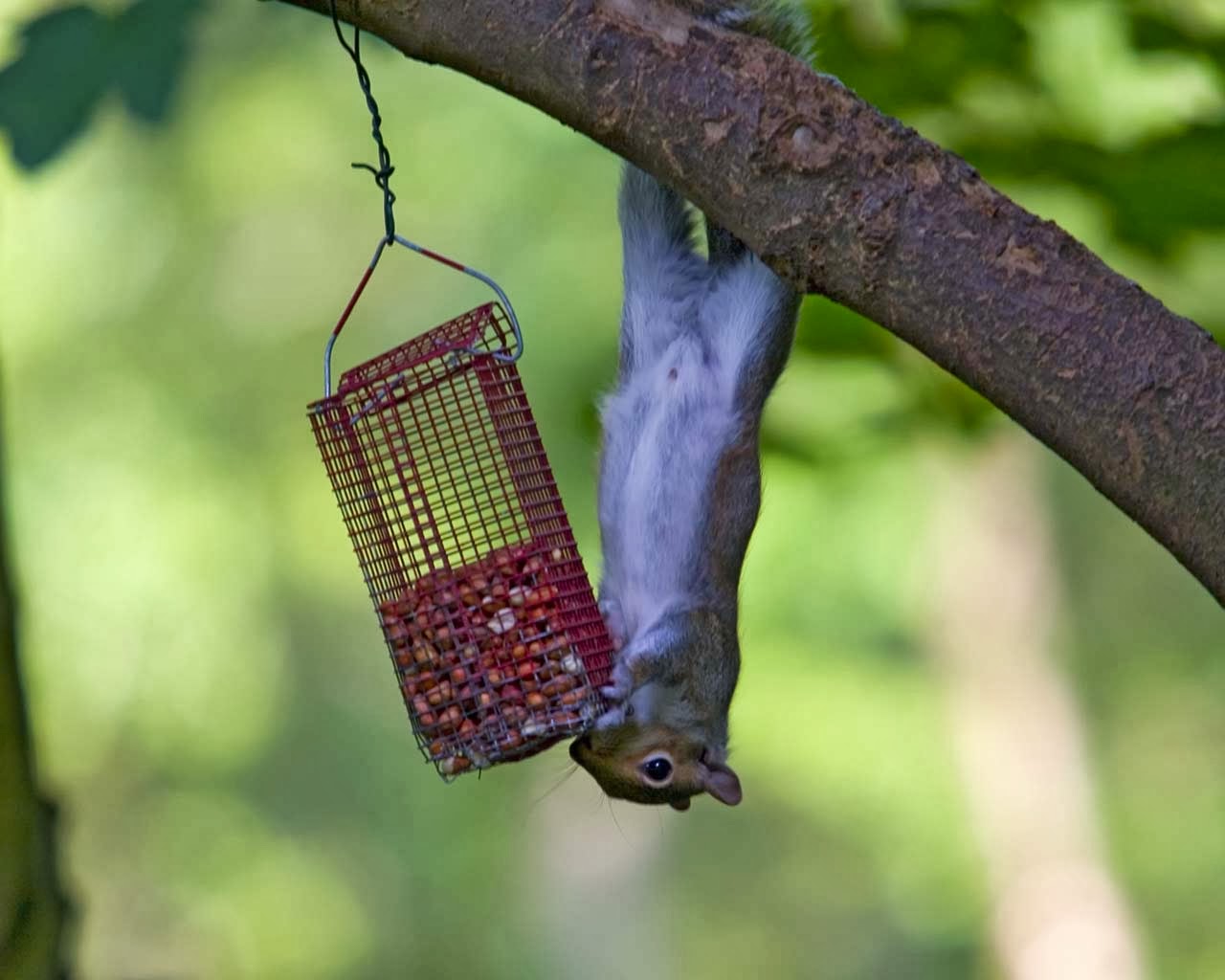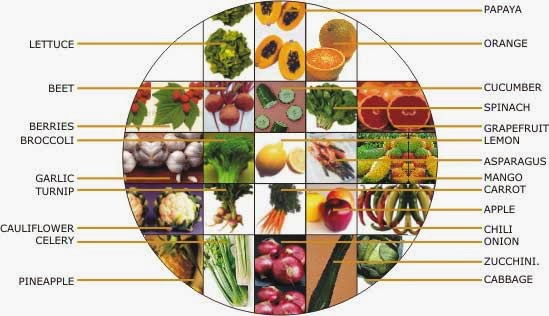Biology
Diseases of the mind are often more bizarre and more tragic than diseases of the body. Medicine and psychiatry use different terminology; terms of the mind are often less specific than terms of anatomy and physiology. For instance, what?s the difference between a psychopath and a sociopath?
There?s no inherent advantage in altered TRPV1 signaling via capsaicin for H. glaber; they don?t eat chili peppers. But remember that TRPV1 is activated by more than just capsaicin, so perhaps the advantage lies in stopping some other activation of TRPV1 and it just so happens that it also stops capsaicin?induced pain.
A neurotransmitter called Substance P is also important in TRPV1 pain signaling. Are you getting the idea that this is a complicated system - I sure am. It turns out that naked mole rats don?t make substance P (2010). Now we have three different reasons that naked mole rats don?t transmit pain signals via TRPV1. This is an evolutionary overkill, but it makes the mole rats able to live where they live without fear of unnecessary pain.
The answer is seed dispersal. It is important that chili peppers are consumed and the seeds are spread. This is crucial for the survival of the plant species. But if the fruits are spicy and there is avoidance of same by most animals, how will the seeds be spread? Well, there better be some animals that don?t react to capsaicin ? birds.
You can inject huge amounts of capsaicin extract into the veins of ducks without them having any kind of a thermal response. Since TRPV1 senses heat and then initiates a cooling process, capsaicin in the blood will result in too much cooling ? a hypothermia. In chickens this hypothermia occurs, but not in ducks.
Another recent study shows that the decrease in energy your body expends when you diet (an evolutionary adaptation to try and maximize fat reserves) is prevented by consuming capsaicin. So you burn more calories with spicy food and your body doesn?t even realize your dieting. Somebody should try breeding a capsaicin-packed celery stalk.
Smeets AJ, Janssens PL, & Westerterp-Plantenga MS (2013). Addition of capsaicin and exchange of carbohydrate with protein counteract energy intake restriction effects on fullness and energy expenditure. The Journal of nutrition, 143 (4), 442-7 PMID: 23406619
Clegg ME, Golsorkhi M, & Henry CJ (2013). Combined medium-chain triglyceride and chilli feeding increases diet-induced thermogenesis in normal-weight humans. European journal of nutrition, 52 (6), 1579-85 PMID: 23179202
Smith ES, Omerba?i? D, Lechner SG, Anirudhan G, Lapatsina L, & Lewin GR (2011). The molecular basis of acid insensitivity in the African naked mole-rat. Science (New York, N.Y.), 334 (6062), 1557-60 PMID: 22174253
Park TJ, Lu Y, Jüttner R, Smith ES, Hu J, Brand A, Wetzel C, Milenkovic N, Erdmann B, Heppenstall PA, Laurito CE, Wilson SP, & Lewin GR (2008). Selective inflammatory pain insensitivity in the African naked mole-rat (Heterocephalus glaber). PLoS biology, 6 (1) PMID: 18232734
Smith ES, Blass GR, Lewin GR, & Park TJ (2010). Absence of histamine-induced itch in the African naked mole-rat and "rescue" by Substance P. Molecular pain, 6 PMID: 20497578
- Chili Peppers Run Hot And Cold
Biology concepts ? obesity, brown adipose tissue, agonist/antagonist, protective hypothermia, hyperthermia, reactive oxygen species, ischemia, hypoxia When The Wizard of Oz was released in 1939, it just barely turned a profit. The '39 version was...
- Capsaicin ? Adding To Or Taking Your Pain
Biology concepts ? hyperalgesia, allodynia, analgesia, sensitization, potentiation, desensitization, habituation, burning mouth syndrome Apparently this is how people shovel snow in the cold climates. I agree with the form; always bend with your...
- It?s Not Just Chili Peppers That Are Hot
Biology concepts ? cinnamaldehyde, nasal hyperreactivity, piperine, allyl isothiocyanate, eugenol, gingerol, tinyatoxin, osmotic stress, agonist/antagonist The last few years have seen the rise and fall of The Cinnamon Challenge. I can?t tell you why...
- Are Chilies Spicy, Hot, Or Piquant?
Biology concepts ? fruit, spice, capsaicin, Scoville heat units, TRPV1 heat sensor, taste, true berry Preface: I had intended on finishing our series on taste sense with a single post on how spicy foods are a taste exception. But the information and...
- Take Off Your Coat And Stay Awhile
Biology concepts ? thermoregulation, ectothermy, endothermy, genetic mutation Let me introduce you to the most wondrous animal on the surface of the Earth, or under the surface of the Earth ? the naked mole rat, Heterocephalus glaber (hetero ...
Biology
Naked Mole Rats Don?t Feel The Burn
Biology concepts ? thermoregulation, heat sensing, TRPV1, evolution, neurotransmitters, birds, ectothermy, diet-induced thermogenesis
 |
| BBC television has a very nice Sherlock Holmes show running nowadays, but it has ticked off some mental health professionals. Sherlock describes himself as a high functioning sociopath. I have read several angry letters from those in the profession saying that he should stop doing so, he is using a mental disorder as an excuse for just plain rude behavior. |
There is an argument currently raging as to whether there is any difference between these two labels for anti-social personality disorder. The major similarity is in self-centered actions without remorse for doing wrong to others. The differences may lay in organization. Psychopaths are impulsive while sociopaths may plan things out and use charm to conceal themselves. Others say psychopathy is genetic and sociopathy is learned. But both groups are fine with breaking rules.
This blog has used rule breakers as models for explaining biology concepts, just as medicine uses them as ways to find corrections for when things go wrong. If one animal could be the poster child for rule breaking in biology, it would have to be the naked mole rat (Heterocephalus glaber). There are so many rules that this animal breaks or ignores, it makes one wonder if it's a sociopath or a psychopath.
In truth, the naked mole rat has no motivation for breaking rules. It?s merely a reflection of the evolutionary forces that its ancestors felt, adaptations to pressures over a long period of time. If rules had to be broken, so be it. It?s evolution that?s the psychopath.
The broken rules we are concerned with in this post relate to TRPV1. The capsaicin of chili peppers does not inflict pain on naked mole rats! H. glaber TRPV1 binds capsaicin just fine, it just doesn?t result in pain. The difference comes in the spinal cord. A 2008 paper shows that the connections from the TRPV1 expressing nociceptive neurons to those neurons that would convey the signal to the brain are different in naked mole rats, and the additional pathways result in a loss of the pain signal.
 |
| This isn?t just a pile of naked mole rats that someone dumped out of a bucket. This is how they sleep. They use each other to keep warm because they are cold blooded. A cold-blooded mammal? Well, I never imagined. But they break more rules ? they live much longer than other mammals, they don?t get cancer, and they have a queen like in bee hives. Drum roll please ? the naked mole rat was named the vertebrate of the year for 2013 by Sciencemagazine. |
One of those other TRPV1 activators is acid. We said that a pH below 5.5 activates TRPV1 and a pH between 5.5 and 6.5 makes TRPV1 more sensitive. This is pertinent for naked mole rats because they live entirely below ground. Their tunnels are high in CO2 from all their exhalations. Excess CO2 in the tissues causes an acidosis, a low pH situation. If the H. glaber TRPV1 acted as it does in every other mammal, then naked mole rats would be in constant pain.
New research (2011) shows that the acid does indeed make naked mole rat TRPV1 channels open just as capsaicin does, but the neurons don?t fire. Acid suppresses a certain sodium channel downstream of TRPV1. Normally, the calcium influx mediated by TRPV1 activates the Nav1.7 sodium channel, and the neuron is depolarized and fires. But acid destabilizes the Nav1.7 channel and there is reduced firing.
This suppression occurs in all mammals, but it is a much stronger suppression in naked mole rats, because two amino acids are changed in their version of Nav1.7. Now we have two TRPV1 activators (capsaicin and acid) that no longer result in pain, but for two different reasons. Is there more?
 |
| Substance P is a neurotransmitter and modulator that is important for pain signaling, but it also works in vomit regulation. In the medulla of the brain lies the vomit center, and it uses substance P to induce a reversal of the motion of the GI muscles that usually moves food through the GI tract. A spike of substance P in the wrong place, and here comes supper for a return engagement. |
But the question remains, did the mutations in TRPV1 signaling permit H. glaber to move permanently underground, or did living underground put pressure on the naked mole rat to adapt through TRPV1 mutations? It?s hard to tell which was the cart and which was the horse.
The naked mole rat?s lack of pain signaling via TRPV1 may help us humans. The more we know about the mechanisms of H. glaber TRPV1 action, the better we can design pain killers for ourselves. Exceptions can often be our savior.
Another rule that naked mole rats break is that they are cold-blooded (ectothermic) mammals. We know that TRPV1 is important in heat sensing, so does having altered TRPV1 pathways mean that the naked mole rat can?t thermoregulate and that?s why it?s ectothermic?
The rats can still probably sense heat. Remember that there are other TRPV proteins that are important in heat sensing; nothing says these aren?t functioning just fine. For that matter, there is no evidence that the TRPV1 of H. glaber is defective in heat sensing. It just doesn?t result in a pain sensation.
And it would be wrong to believe that ectotherms don?t need to sense heat. It may be even more crucial for ectotherms. Cold-blooded animals must find the heat in their environment and soak it in ? but not too much. This means they must be experts at knowing how much heat they have and where they can find more.
Ectotherms also need to know where the shade is, so they can cool off if they get too hot. To prove this, we know that reptiles with mutated thermosensors don?t shuttle between warmer and cooler areas and can?t maintain a satisfactory physiologic temperature.
As weird as the naked mole rat is, birds also seem to break the rules when it comes to TRPV1; they can order their food spicy as well. Why is it significant that birds don?t sense capsaicin as burning pain? Remember that chilies are a group of plants with fruits. Those plants have evolved capsaicin to inhibit herbivorous predators and fungal infections, as we talked about last week. Now we have the fact that birds don?t react to capsaicin. How are these linked?
 |
| Squirrels are the bane of every backyard birder?s existence. They eat ten times as much feed as the birds, and they can find some creative ways to reach the bird food. Try adding pepper flakes to the bird feed, squirrels feel the burn, but your song bird visitors won?t. |
The TRPV1 of most birds doesn?t have a vanilloid binding site. The channels work for heat sensing and do react to acids, but there is no activation by capsaicin. Since there is no capsaicin binding site, birds only taste the peppers, they don?t get the burn. It's possible that they taste the many different vanilloid compounds, so peppers may taste a little like vanilla to birds.
I still have one question ? there's certainly a reproductive advantage for peppers when birds don?t sense capsaicin (for seed dispersal), but where is the advantage for birds? And how could pepper plants force the evolution of a different TRPV1 in birds? One possibility - maybe birds evolved a different TRPV1 to take advantage of a food source that other animals avoid. No competition for food would definitely be a reproductive advantage for birds.
But this explanation has exceptions as well. The TRPV1 of chickens is activated by capsaicin. It is weak, taking 3-4 times more capsaicin to get a reaction, but it does work. So if you own chickens, don?t give them very spicy feed. Ducks on the other hand, have a TRPV1 that doesn?t sense capsaicin or heat.
 |
| Some foods are considered negative calorie items. They supposedly cost more to digest than the energy they provide in calories. I?m not sure if I believe that all these foods are negative calorie foods. If they were, there would be a lot of starving vegetarians. If not dead, they would be awfully weak and tired. |
So thermosensing must be important. Even in most animals that don?t respond to capsaicin, their TRPV1 still works in thermoregulation. I can give you an idea of how intricate and detailed this thermoregulatory system is by talking about digesting spicy food. Your body uses energy and metabolism to digest the food you eat. This energy use produces heat as a byproduct, and warms you up a bit. This is called diet-induced thermogenesis. Celery is an excellent diet food because the energy you use to digest it is the same or more than the calories in the celery itself.
For some reason, spicy foods increase diet-induced thermogenesis; you expend more energy and heat up more when eating spicy foods than when eating the same foods without the capsaicin. Recent evidence indicates that including capsaicin and medium chain triglycerides in a meal will increase diet-induced thermogenesis by over 50%. This combination also makes you feel full sooner and therefore decreases overall caloric intake.
The spice also makes you use more energy for digestion, but it also makes your body think it is warmer than it is, so it tries to cool down. Cooling down also takes energy, so eating spicy food really does burn more calories - maybe because fat takes more energy to digest and capsaicin is a lipid-like molecule.
 |
| Some weird products include capsaicin for the supposed health benefits. Here are capsaicin drinks. Including capsaicin in a diet will help you eat less, but I am thinking it may be because you just get tired of sweating and feeling like your mouth is on fire. |
Next week we'll see that TRPV1 is even more amazing. Not every spicy food contains capsaicin, there?s mustard, black pepper, horseradish, ginger, cinnamon, etc. Some of these even make your capsaicin seem spicier.
For more information or classroom activities, see:
Naked mole rat ?
http://animals.nationalgeographic.com/animals/mammals/naked-mole-rat/
http://www.youtube.com/watch?v=eHi9FvUPSdQ
http://www.bbc.co.uk/nature/life/Naked_mole_rat
http://www.latimes.com/science/sciencenow/la-sci-sn-mole-rat-longevity-20131001,0,6184646.story
http://www.sciencefriday.com/video/10/24/2013/the-inner-beauty-of-naked-mole-rats.html
http://www.huffingtonpost.com/2012/07/03/naked-mole-rat_n_1646441.html
http://www.sciencedaily.com/releases/2013/07/130731093255.htm
http://www.scientificamerican.com/article/naked-mole-rat-named-vertebrate/
Substance P ?
http://arthritis.about.com/od/arthqa/f/substanceP.htm
http://www.medscape.com/viewarticle/409781
http://www.wisegeek.com/what-is-substance-p.htm
http://aqua4balance.com/health-conditions/fibromyalgia-syndrome/serotonin-and-substance-p.html
http://www.rndsystems.com/cb_detail_objectname_SP98_SubstanceP.aspx
http://www.wellnessresources.com/health_topics/cardiovascular-health/substancep.php
Seed dispersal ?
http://www.google.com/url?sa=t&rct=j&q=&esrc=s&source=web&cd=1&ved=0CCoQFjAA&url=http%3A%2F%2Fwww.greeningaustralia.org.au%2Fuploads%2FOur%2520Services%2520-%2520Toolkit%2520pdfs%2FVIC_Landlearn_Activity_7_The_Peter_Pan_theory_of_seed_dispersal.pdf&ei=jFpwUpLgNPCWyAHugoGQAQ&usg=AFQjCNE0XiOySiVyQlyugDs8Uoag-lA4Vw&sig2=gPxSpKjD-07SIlS-ALf1WQ&bvm=bv.55123115,d.aWc
http://www.rspca.org.uk/education/teachers/lessonplandetails/-/education/LifeCyclesPollinationAndDispersal/section/aimsObjectives
http://www.google.com/url?sa=t&rct=j&q=&esrc=s&source=web&cd=3&ved=0CDoQFjAC&url=http%3A%2F%2Fwww.mbgnet.net%2Fbioplants%2Fdownloads%2Fseeds.pdf&ei=jFpwUpLgNPCWyAHugoGQAQ&usg=AFQjCNFYW8CmWV8hX39O_IrPpMc6mAXVqg&sig2=G6IQ4g3clVYTbhkTaxPGrA&bvm=bv.55123115,d.aWc
http://seeddispersallessonplan.blogspot.com/2011/02/seed-dispersal-lesson-plan.html
http://www.google.com/url?sa=t&rct=j&q=&esrc=s&source=web&cd=15&ved=0CHUQFjAO&url=http%3A%2F%2Fwww.aginclassroom.org%2FSchool%2520Gardens%2FSchool_Gardening_Lesson_Plans%2FSeeds%2520Lesson%2520-%2520Grade%25203%2520-%2520%2520Seed%2520Dispersal.pdf&ei=jFpwUpLgNPCWyAHugoGQAQ&usg=AFQjCNHhNc7leehidMxsA-DqJgO7qikffA&sig2=osk7QWnimRxTJIdrfoFIfQ&bvm=bv.55123115,d.aWc
http://www.google.com/url?sa=t&rct=j&q=&esrc=s&source=web&cd=25&ved=0CEQQFjAEOBQ&url=http%3A%2F%2Fwww.teacherlink.org%2Fcontent%2Fscience%2Finstructional%2Factivities%2Fseeds%2Fseeds-print.pdf&ei=iVtwUq6hOaOiyAHnjIDwAQ&usg=AFQjCNGnvydovXHPh_kBQ3e9evwxMl8CJg&sig2=IqVVbE49hWD21vAIcrRyIg&bvm=bv.55123115,d.aWc
http://gardenatschool.wordpress.com/2012/05/17/seed-dispersal-ideas/
http://www2.bgfl.org/bgfl2/custom/resources_ftp/client_ftp/ks2/science/plants_pt2/dispersal.htm
http://waynesword.palomar.edu/plfeb99.htm
http://www.cas.vanderbilt.edu/bioimages/pages/fruit-seed-dispersal.htm
http://www.mbgnet.net/bioplants/seed.html
http://andromeda.cavehill.uwi.edu/Dispersal.htm
http://www.jstor.org/discover/10.2307/20046315?uid=3739664&uid=2129&uid=2&uid=70&uid=4&uid=3739256&sid=21102836267737
http://www.vtaide.com/png/seed-dispersion.htm
http://theseedsite.co.uk/dispersal.html
Diet-induced thermogenesis -
http://www.ncbi.nlm.nih.gov/pubmed/15507147
http://www.google.com/url?sa=t&rct=j&q=&esrc=s&source=web&cd=5&ved=0CF0QFjAE&url=http%3A%2F%2Fwww.ncsf.org%2Fpdf%2Fceu%2Fdiet_induced_thermogenesis.pdf&ei=KqkCU6aGPKrA2QW2o4HADA&usg=AFQjCNE0youH2pxOSQmkDOHSNj6RvE01lA&sig2=OHM0UsrlJssg4stkIJ3DTA&bvm=bv.61535280,d.b2I
http://www.livestrong.com/article/461015-definition-of-dietary-thermogenesis/
http://eurekamag.com/research/005/188/does-diet-stimulated-thermogenesis-change-preferred-ambient-temperature-humans.php
http://www.30bananasaday.com/profiles/blogs/something-i-just-wrote-about-dietary-thermogenesis
http://books.google.com/books?id=aW0WAAAAQBAJ&pg=PT110&lpg=PT110&dq=%22dietary+thermogenesis%22&source=bl&ots=OUGWErvwFf&sig=IIhlQGpuorpeCpyH1VC1c1fKvH4&hl=en&sa=X&ei=1KwCU8qRLcGG2wWproDICg&ved=0CC0Q6AEwATgK#v=onepage&q=%22dietary%20thermogenesis%22&f=false
- Chili Peppers Run Hot And Cold
Biology concepts ? obesity, brown adipose tissue, agonist/antagonist, protective hypothermia, hyperthermia, reactive oxygen species, ischemia, hypoxia When The Wizard of Oz was released in 1939, it just barely turned a profit. The '39 version was...
- Capsaicin ? Adding To Or Taking Your Pain
Biology concepts ? hyperalgesia, allodynia, analgesia, sensitization, potentiation, desensitization, habituation, burning mouth syndrome Apparently this is how people shovel snow in the cold climates. I agree with the form; always bend with your...
- It?s Not Just Chili Peppers That Are Hot
Biology concepts ? cinnamaldehyde, nasal hyperreactivity, piperine, allyl isothiocyanate, eugenol, gingerol, tinyatoxin, osmotic stress, agonist/antagonist The last few years have seen the rise and fall of The Cinnamon Challenge. I can?t tell you why...
- Are Chilies Spicy, Hot, Or Piquant?
Biology concepts ? fruit, spice, capsaicin, Scoville heat units, TRPV1 heat sensor, taste, true berry Preface: I had intended on finishing our series on taste sense with a single post on how spicy foods are a taste exception. But the information and...
- Take Off Your Coat And Stay Awhile
Biology concepts ? thermoregulation, ectothermy, endothermy, genetic mutation Let me introduce you to the most wondrous animal on the surface of the Earth, or under the surface of the Earth ? the naked mole rat, Heterocephalus glaber (hetero ...
